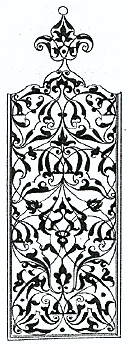No. 7 Favorite Design Styles
Understanding design periods begin with understanding geography and socio-economic and political history… 
The Style: With influence of Persian, Medieval, Renaissance, Baroque, Spanish, Mediterranean, Moroccan, and more… this style is commonly seen with wrought iron details, arabesques, colorful geometric patterned tiles, warm terra cottas, rich dark woods, plaster walls, beamed ceilings, heavy furniture. This style leads into the
Mexican Hacienda Style, it influences the southwest style, is indicative of the California Mission style, and is reawakened with an updated during the Mission style revival 1890 – 1915 and Spanish Colonial Revival 1915- 1931. There is a richness and a romance that embodies this design. See below for more history.I just want to sit back and listen to Classical Spanish Guitar (click on the video to enjoy) scroll through the Art de Mexico Furnishings and Lighting Catalog - and dream of the designing a rich luxurious Spanish Colonial Estate.
Great examples and descriptions: http://decortoadore.blogspot.com/2008/09/spanish-colonial-interiors.html (two photos immediately below are from that blog)



History Lesson: What is Moorish, who were the Moors? Moors were Muslims who invaded Spain in the 8th century and established a civilization in Andalusia that lasted until the late 15th century also known as a Muslim people of mixed Berber and Arab descent, now living chiefly in northwest Africa. When something is called 
Mudéjar: Mudéjar is the name given to the Moors or Muslims of Al-Andalus who remained in Christian territory after the Reconquista but were not converted to Christianity. It also denotes a style of Iberian architecture and decoration, particularly of Aragon and Castile, of the 12th to 16th centuries, strongly influenced by Moorish taste and workmanship. The word Mudéjar is a Medieval Spanish corruption of the Arabic word Mudajjan مدجن, meaning "domesticated", in a reference to the Muslims who have submitted to the rule of the Christian kings. After the fall of Granada in January of 1492, Mudéjars kept their status for some time. However, they were forced to convert to Christianity in the mid 16th century, and were known as Moriscos from that time until those who refused to convert to Christianity were expelled in 1610. Their distinctive style is still evident in architecture as well as the music, art, and crafts of the region. http://en.wikipedia.org/wiki/Mud%C3%A9jar
In 1492, Spain drove out the last Moorish king of Granada. After their victory, the Spanish monarchs negotiated with 
Spain took this hint of Persian, Medieval - Renaissance, Mediterranean style and introduced it to it’s conquests – creating colonies that reflect this flavor, yet used many local products and craftsmen – giving it a flair all of its own. An example Diego Columbus’ Home (Son of Christopher Columbus and First Governor of the New World, Santo Domingo, Dominican Republic – see photos below) was constructed from dead coral which was a readily available product, durable and carve-able like the building stones in Europe. This stone also was used in the first Cathedral of the new world.











No comments:
Post a Comment